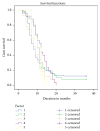Visual Internal Urethrotomy for Adult Male Urethral Stricture Has Poor Long-Term Results
- PMID: 26494995
- PMCID: PMC4606400
- DOI: 10.1155/2015/656459
Visual Internal Urethrotomy for Adult Male Urethral Stricture Has Poor Long-Term Results
Abstract
Objective. To determine the long-term stricture-free rate after visual internal urethrotomy following initial and follow-up urethrotomies. Methods. The records of all male patients who underwent direct visual internal urethrotomy for urethral stricture disease in our hospital between July 2004 and May 2012 were reviewed. The Kaplan-Meier method was used to analyze stricture-free probability after the first, second, third, fourth, and fifth urethrotomies. Results. A total of 301 patients were included. The overall stricture-free rate at the 36-month follow-up was 8.3% with a median time to recurrence of 10 months (95% CI of 9.5 to 10.5, range: 2-36). The stricture-free rate after one urethrotomy was 12.1% with a median time to recurrence of eight months (95% CI of 7.1-8.9). After the second urethrotomy, the stricture-free rate was 7.9% with a median time to recurrence of 10 months (95% CI of 9.3 to 10.6). After the third to fifth procedures, the stricture-free rate was 0%. There was no significant difference in the stricture-free rate between single and multiple procedures. Conclusion. The long-term stricture-free rate of visual internal urethrotomy is modest even after a single procedure.
Figures
Similar articles
-
Urethrotomy has a much lower success rate than previously reported.J Urol. 2010 May;183(5):1859-62. doi: 10.1016/j.juro.2010.01.020. Epub 2010 Mar 29. J Urol. 2010. PMID: 20303110
-
Treatment of male urethral strictures: is repeated dilation or internal urethrotomy useful?J Urol. 1998 Aug;160(2):356-8. doi: 10.1016/s0022-5347(01)62894-5. J Urol. 1998. PMID: 9679876 Clinical Trial.
-
Direct visual internal urethrotomy: Is it a durable treatment option?Urol Ann. 2017 Jan-Mar;9(1):18-22. doi: 10.4103/0974-7796.198835. Urol Ann. 2017. PMID: 28216923 Free PMC article.
-
Endoscopic management of traumatic posterior urethral stricture: early results and followup.J Urol. 1997 Jan;157(1):95-7. J Urol. 1997. PMID: 8976224 Review.
-
Comparison between cold knife and laser urethrotomy for urethral stricture: a systematic review and meta-analysis of comparative trials.World J Urol. 2019 Dec;37(12):2785-2793. doi: 10.1007/s00345-019-02729-3. Epub 2019 Mar 20. World J Urol. 2019. PMID: 30895360
Cited by
-
Decellularization of the human urethra for tissue engineering applications.Exp Biol Med (Maywood). 2023 Jun;248(12):1034-1042. doi: 10.1177/15353702231162092. Epub 2023 Apr 18. Exp Biol Med (Maywood). 2023. PMID: 37073134 Free PMC article.
-
Tissue Engineering of the Urethra: From Bench to Bedside.Biomedicines. 2021 Dec 15;9(12):1917. doi: 10.3390/biomedicines9121917. Biomedicines. 2021. PMID: 34944733 Free PMC article. Review.
-
Endoscopic Management of Urethral Stricture: Review and Practice Algorithm for Management of Male Urethral Stricture Disease.Curr Urol Rep. 2018 Feb 26;19(3):19. doi: 10.1007/s11934-018-0771-6. Curr Urol Rep. 2018. PMID: 29479640 Review.
-
Initial experience with Allium™ stent in the management of bulbar urethral stricture.Transl Androl Urol. 2017 Jul;6(Suppl 2):S88-S91. doi: 10.21037/tau.2017.04.19. Transl Androl Urol. 2017. PMID: 28791227 Free PMC article. Review.
-
Update on managing anterior urethral strictures.Indian J Urol. 2019 Apr-Jun;35(2):94-100. doi: 10.4103/iju.IJU_52_19. Indian J Urol. 2019. PMID: 31000913 Free PMC article. Review.
References
LinkOut - more resources
Full Text Sources
Other Literature Sources
Medical


